Wartime Heritage
ASSOCIATION

copyright © Wartime Heritage Association
Website hosting courtesy of Register.com - a web.com company
Battle of the Bulge
Nova Scotians in the Ardennes Offensive
The Battle of the Bulge (Battle of the Ardennes)
Remembering the casualties with ties to Nova Scotia
In the wake of the successful advance of the Allied forces, it would
have been seen by some as if the Second World War was all but over in
the fall of 1944. Yet, on the early misty morning of December 16th
with the onset of winter, the German army launched a counter-
offensive that was intended to cut through the Allied forces in a
manner that would turn the tide of the war in Hitler's favour.
The Battle of the Bulge (December 16, 1944–end of January 1945),
also known as the Ardennes Offensive, was the largest battle fought
on the Western Front in Europe during WWII. It is also the largest
battle ever fought by the United States Army. The offensive intended
to drive a wedge between the American and British armies in France
and the Low Countries and recapture the port of Antwerp in the
Netherlands to deny the Allies use of the port facilities. The enemy
codename for the buildup to the offensive was Watch on the Rhine
(Wacht am Rhine). The offensive itself was codenamed Operation
Autumn Mist (Unternehmen Herbstnebel). It fell far short of its goals
but managed to create a bulge in the American lines 50 miles wide
and 70 miles deep, which gave the struggle its alliterative name.
More than 200,000 German troops and nearly 1,000 tanks launched Adolf Hitler's last bid to reverse
the ebb in his fortunes. Seeking to drive to the coast of the English Channel and split the Allied
armies as they had done in May 1940, the Germans struck in the Ardennes Forest, a 75-mile stretch
of the front characterized by dense woods and few roads, held by four generally inexperienced and
battle-worn American divisions stationed there for rest and seasoning.
After a day of hard fighting, the Germans broke through the American front, surrounding most of an
infantry division, seizing key crossroads, and advancing their spearheads toward the Meuse River,
creating the projection that gave the battle its name.
The Allied line bulged, but did not break.
There were undoubtedly surviving Veterans of the Battle of the Bulge that were from Nova Scotia,
and there were at least seven men with ties to NS that died in the Battle of the Bulge.
The 347th Infantry Regiment was one of the first units to begin the movement north to relieve the
beleaguered American troops in the Ardennes. Private James Russell Muise of Gloucester, Mass., the
son of Eugene J Meuse born in Amirault’s Hill and Mary L White born in Abrams River, Yarmouth Co.,
Nova Scotia, was killed December 18, 1944, in the fighting to push back the enemy. Private Donald
James Boudreau of Yarmouth, NS, was killed in action 2 days before Christmas on December 23, 1944,
also serving with the 347th.
A vital exception to the bulge created in the lines was Bastogne. Bastogne was a crossroad of
paramount importance. Bastogne provided a road junction in rough terrain where few roads existed
and it would have opened up an efficient and valuable pathway further north for German expansion.
The American forces that were surrounded in and around Bastogne meant nothing but delay for the
enemy. The Ardennes Offence relied heavily on speed and making it over the Meuse River on the way
to the coast. On December 26th, Bastogne’s defenders received a belated Christmas present. Lieutenant Charles Boggess with a few
M4 Sherman tanks fought his way into Bastogne from the south. They were the lead element of a relief force from Lieutenant General
George S. Patton‘s Third Army. When Patton struck with three divisions the following day, the German ring around Bastogne was
broken. Patton's Third Army relieved Bastogne, and to the north, the 2nd US Armored Division stopped enemy tanks short of the Meuse
River on Christmas. Through January, American troops, often wading through deep snow drifts, attacked the sides of the shrinking
bulge until they had restored the front and set the stage for the final drive to victory.
The 550th Glider Airborne Battalion was in a similar position to the 347th Infantry Regiment, fighting from the south west of the Bulge
to push back the advance. Private First Class Clyde Arnold Larkin , born in Lockeport, Shelburne County, NS, served with the 550th
and was killed in action January 2, 1945.
The 314th, an infantry regiment of the 79th Division, held a defensive line along the Lauter River, at
Wissembourg from December 20, 1944, until January 2, 1945, when it withdrew to Maginot Line
defenses. The German attempt to establish a bridgehead west of the Rhine at Gambsheim resulted in
furious fighting. The 79th beat off German attacks at Hatten and Rittershoffen in an 11-day battle before
withdrawing to new defensive positions south of Haguenau on the Moder River on January 19th. Technical
Sergeant John Charles McLean was killed in action January 10th, most likely near Reipertswiller in
France.
Private Edward Frederick Amirault, born in Yarmouth, NS, was killed in the attack on Mande-St. Etienne,
Belgium, on January 2, 1945. The attack started in mid-afternoon. Both infantry and armored task forces
moved into the town but were forced to fight street to street and cellar to cellar all through the night
before securing full possession of the town.
On January 15, 1945, the 1st Division known as the Big Red One launched its part of the Allied counter-
offensive to ‘reduce the Bulge’. Staff Sergeant Grant Harding Conroy, the son of Ethel Conroy of
Bridgetown, Annapolis County, NS, was killed in action on January 18th serving with the 1st Division in the
16th Infantry Regiment. The Division raced to the Ardennes, and fighting continuously from December 17,
1944 to January 28, 1945, helped blunt and turn back the German offensive. Private Clyson Elroy Lewis,
the son of Gordon Lewis of Terence Bay, Halifax, NS, was also killed in action January 18th serving with
the 18th Infantry Regiment of the 1st Division.
By the end of December and into January, the German offensive was running out of fuel. The Germans had
waited for bad winter weather to launch their attack, to diminish the ability of Allied aircraft to support
the ground troops. The weather also slowed the German advance, added to this - the narrow roads and
stubborn resistance - wrecked their timetable. Improving weather conditions allowed Allied planes to take
to the skies again and support the counter-attacks that began pushing back the enemy. Despite a Luftwaffe offensive in Holland and a
second major ground offensive the Germans launched in Alsace on January 1st, the enemy could not regain the initiative. The Battle
of the Bulge is officially considered to have ended January 16, exactly one month after it began, although fighting continued for some
time beyond that date. By late January / early February, the front lines had returned to their positions of December 16th.
A month of bitter fighting in winter cold and deep snow cost the
Allies nearly 80,000 casualties when including captured and
wounded; some 19,000 Americans were killed. The Germans lost
approximately 100,000 men, who could not be replaced militarily.
Fought primarily between German and American forces, there was
also approximately 55,000 troops of the British Army, which included
the 1st Canadian Parachute Battalion of the Canadian Army, that
participated in the struggle. British and Canadian casualties were
approximately 1,400 killed, wounded and missing.
The Ardennes Offensive was a huge gamble on the part of German
dictator Adolf Hitler, one that he lost badly.

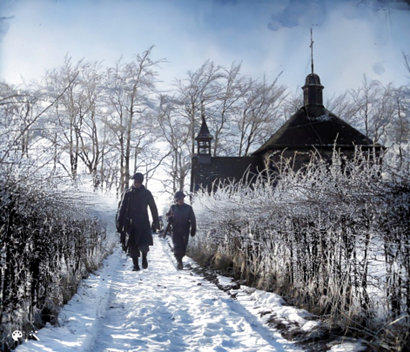
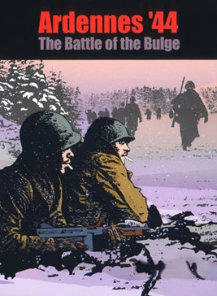
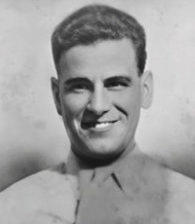
Donald J. Boudreau
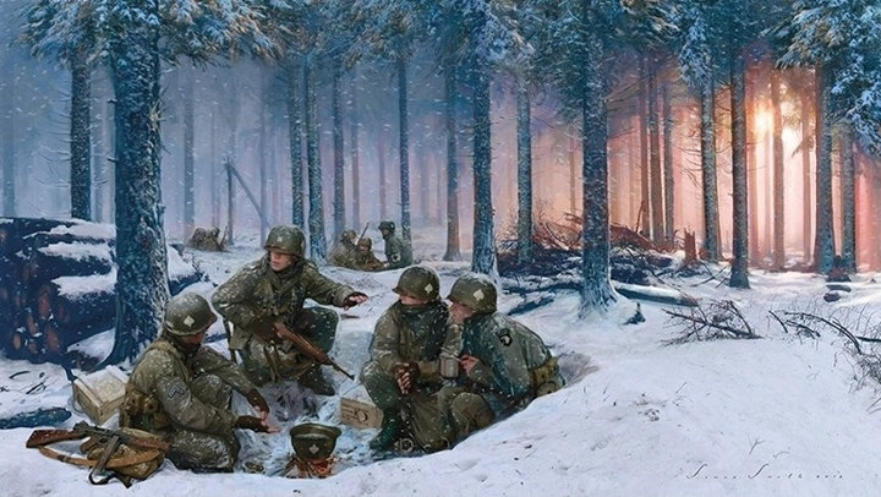
The Hell that was Bastogne, by Simon Smith
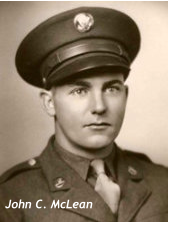
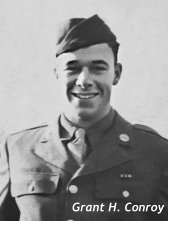
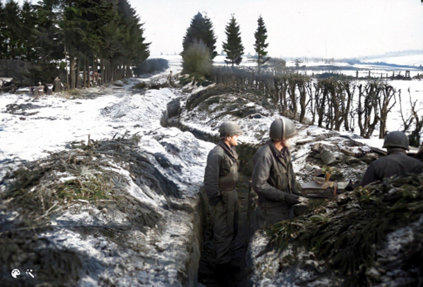
Nova Scotians who died in the Battle of the Bulge:
Michael Bernard Penney, lost December 17, 1944 - Read his story at:
http://wartimeheritage.com/whaww2ns6/wwii_penney_michael_bernard.htm
James Russell Meuse, lost Dec 18, 1944 – Read his story at:
http://wartimeheritage.com/whaww2ns4/wwii_meuse_james_russell.htm
Donald James Boudreau, lost Dec 23, 1944 – Read his story at:
http://wartimeheritage.com/whaww2ns4/wwii_boudreau_donald_james.htm
Clyde Arnold Larkin, lost Jan 2, 1945 – Read his story at:
http://wartimeheritage.com/whaww2ns5/wwii_larkin_clyde_arnold.htm
John Charles McLean, lost Jan 10, 1945 – Read his story at:
http://wartimeheritage.com/whaww2ns5/wwii_mclean_john_charles.htm
Edward Frederick Amirault, lost Jan 12, 1945 – Read his story at:
http://wartimeheritage.com/whawwii/whawwii_amirault_edwin_frederick.htm
Clyson Elroy Lewis lost Jan 18, 1945 – Read his story at:
http://wartimeheritage.com/whaww2ns5/wwii_lewis_clyson_elroy.htm
Grant H. Conroy lost Jan 18, 1945 – Read his story at:
http://wartimeheritage.com/whaww2ns5/wwii_conroy_grant_harding.htm
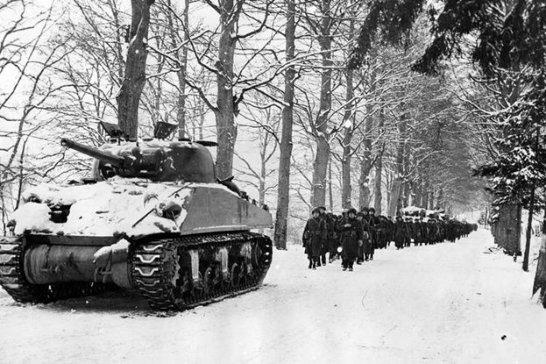
Sources:
https://www.army.mil/botb/
https://www.wsj.com/articles/the-battle-of-the-bulge-was-hitlers-last-gamble-11575694860
https://www.historynet.com/the-battle-of-the-bulge-nazi-germanys-last-gasp/
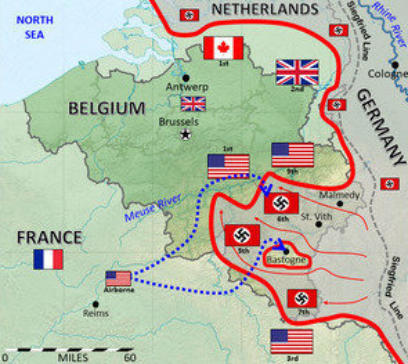
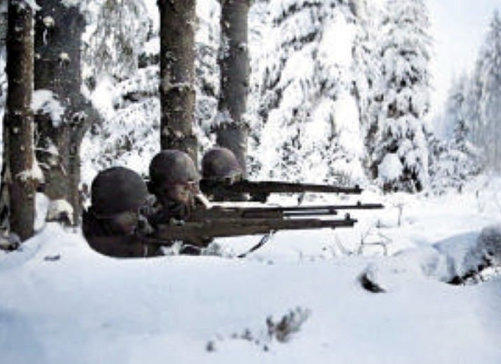


- World War I - Menu
- WWI Stories and Articles
- Photos - Yarmouth Soldiers
- Selection of World War I Songs
- WWI Casualties of Yarmouth, NS
- Those Who Served - Yarmouth, NS
- WWI Casualties Digby Co. NS
- WWI Casualties Shelburne Co. NS
- Merchant Mariners (1915) Yarmouth, NS
- Canadian Forestry Corps - Non Yarmouth Birth/Residence Enlistments
- US Draft Registry - Yarmouth NS Born


- World War II - Menu
- WWII Stories and Articles
- Telegraphist Air Gunners
- WWII Casualties of Nova Scotia
- US Casualties with NS Connection
- Far East/Pacific Casualties with NS Connection
- Merchant Navy Casualties Nova Scotia
- Nova Scotia WWII Casualties Holten Canadian War Cemetery
- D-Day Casualties - Nova Scotia
- CANLOAN Program Casualties - Nova Scotia
- Battle of the Bulge Casualties - Nova Scotia
- WWII Casualties Yarmouth NS
- Yarmouth Casualties - RCAF RAF Canadian Army WWII
- Yarmouth Co., Marrages WWII
- Casualties Non-Born/Residents with Connection to Yarmouth Co., Nova Scotia.
- WWII Casualties Digby Co., NS
- Non-Nova Scotian WWII Casualties Buried in Nova Scotia
- WWII RCAF Casualties Aged 16-18
- Brothers/Sisters Who Served - World War II













